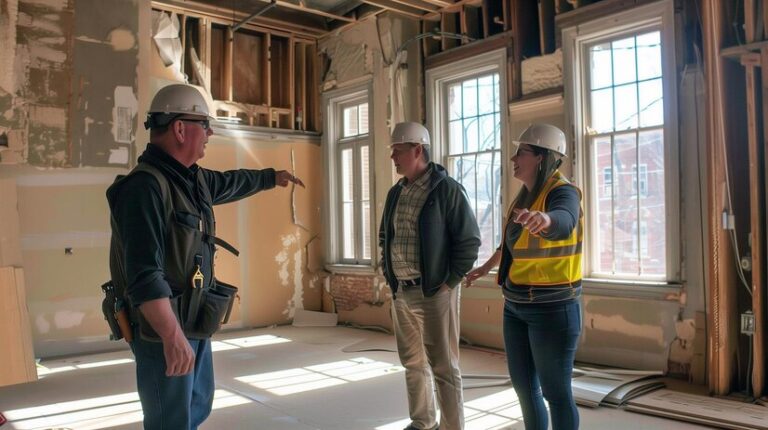Hiring a contractor for a historic home remodel can feel overwhelming, but it’s crucial for preserving your home’s charm and value. Your historic property deserves a professional who understands its unique needs and challenges.
To get the best results, you need to find someone with experience and a passion for historic preservation. This guide will walk you through everything you need to know to make the right choice and ensure your remodel is a success.
Understanding the Unique Challenges of Historic Home Remodels

Remodeling a historic home is quite different from working on a brand-new house. The unique challenges of historic home remodels arise from the age and distinctive charm of these buildings. Understanding these challenges is crucial when selecting contractors for home remodeling. Let’s explore what makes these projects special and what to keep an eye on.
Historical Preservation Requirements
One of the biggest challenges is sticking to historical preservation requirements. Historic homes often have strict rules to keep their original character intact. This means you might need special permits or follow specific guidelines for any changes. Knowing these rules upfront will save you from headaches later.
Structural and Material Considerations
Historic homes come with their own set of structural quirks. Old homes were built with materials and techniques that might not meet modern standards. This can lead to unexpected issues, like discovering old wiring or outdated plumbing when you start your remodel. Being prepared for these surprises helps you handle them better.
Finding the Right Solutions
To tackle these challenges, you’ll need a contractor experienced in working with historic properties. They’ll know how to address these unique issues while keeping the home’s original charm. A good contractor will help you navigate these hurdles and ensure your remodel stays true to its historic roots.
Understanding these unique challenges will make your historic home remodel smoother and more successful. Keep these factors in mind, and you’ll be on your way to creating a beautiful and timeless space.
Finding Qualified Contractors

Finding qualified contractors for your historic home remodel is crucial to ensure that your project goes smoothly and meets your expectations. You want someone who knows how to handle the unique needs of older homes and respects their history. Here’s how to find the right professional for the job.
Researching Potential Contractors
Start by doing some research. Look for contractors who specialize in historic home remodels. You can find them through online directories, local home improvement groups, or by asking for recommendations from friends and neighbors. A contractor with experience in historic homes will understand the specific challenges involved.
Evaluating Contractor Credentials
Once you have a list, check their credentials. Make sure they have the necessary licenses and insurance. Look for certifications that show they are trained and qualified for historic renovations. Also, ask about their experience with similar projects to ensure they have a solid track record.
Reviewing Portfolios and References
Review their portfolios to see examples of past work. This will give you an idea of their style and quality. Don’t hesitate to ask for references from previous clients. Speaking with them can provide valuable insight into the contractor’s reliability and skill.
Finding a qualified contractor means your historic home remodel will be handled with care and expertise. Follow these steps, and you’ll be well on your way to a successful project.
Conducting Interviews and Initial Consultations
Conducting interviews and initial consultations is a key step in hiring the right contractor for your historic home remodel. This process helps you gauge whether a contractor is a good fit for your project and if they understand your vision and needs. Let’s break down how to make these meetings productive and informative.
Key Questions to Ask
When you meet with potential contractors, ask specific questions to get a clear picture of their experience and approach. For example:
- Experience with Historic Homes: “Can you tell me about your previous projects involving historic homes?”
- Preservation Approach: “How do you ensure that the remodel respects the home’s original features?”
- Handling Challenges: “What’s your process for dealing with unexpected issues during the remodel?”
These questions will help you understand their expertise and how they plan to manage your project.
Assessing Communication and Professionalism
Pay attention to how the contractor communicates. Are they clear and responsive? Good communication is essential for a smooth remodel. Also, notice their professionalism. A reliable contractor should be punctual, well-prepared, and respectful of your time and property.
By conducting thorough interviews and consultations, you can find a contractor who is not only skilled but also a good match for your historic home remodel. This step sets the stage for a successful partnership and a beautiful outcome for your project.
Understanding Contracts and Agreements

Understanding contracts and agreements is a crucial part of hiring a contractor for your historic home remodel. These documents lay out the details of your project and help protect both you and the contractor. Let’s break down what you need to know to ensure everything runs smoothly.
Important Contract Components
First, your contract should include a clear scope of work. This means it should detail exactly what tasks the contractor will perform and what materials they will use. You also need to agree on a timeline for the project’s completion. This helps avoid delays and keeps everyone on track.
Payment terms are another key part.
The contract should outline how and when payments will be made. This might include a deposit upfront, with the rest paid in stages as work progresses. Make sure the payment schedule fits your budget and is clear to both parties.
Legal and Compliance Issues
Your contract should also address any legal and compliance issues. This includes ensuring the contractor follows local building codes and preservation laws. Ask about their approach to handling any disputes that may arise and make sure it’s included in the agreement.
By understanding and reviewing these aspects of the contract, you ensure that your historic home remodel proceeds as planned and avoids any unexpected problems. A well-drafted agreement helps protect your investment and keeps the project on track.
Managing the Remodeling Process
Managing the remodeling process is key to ensuring your historic home remodel goes smoothly from start to finish. Once your project is underway, staying on top of things can help prevent problems and keep everything on track. Here’s how to manage your remodel effectively.
Regular Communication and Updates
Good communication with your contractor is essential. Set up regular meetings or check-ins to discuss progress, address any concerns, and make sure the project is on schedule. This helps catch any issues early and keeps everyone on the same page.
Quality Control and Inspections
It’s important to keep an eye on the work being done. Schedule periodic inspections to ensure that the remodel meets your expectations and adheres to historical preservation standards. If you notice any problems, address them right away to avoid bigger issues later.
Handling Changes and Issues
Sometimes, unexpected changes or problems may arise. Be prepared to make decisions quickly but thoughtfully. Discuss any changes with your contractor and understand how they might impact the project’s timeline and budget. Flexibility and clear communication will help you navigate these challenges smoothly.
By managing these aspects of your remodel, you’ll help ensure that your historic home remodel stays on track and meets your vision. Effective management leads to a successful project and a beautifully updated home.
Finalizing the Project
Finalizing the project is the final step in your historic home remodel, and it’s crucial for making sure everything is just right. This is when you ensure that all the work is completed to your satisfaction and your home is ready to enjoy. Here’s how to wrap up your remodel smoothly.
Completion Checklist
Start by going through a detailed completion checklist. Make sure all aspects of the remodel are finished according to your plan. This includes checking that all the work is done, the quality meets your expectations, and any final touches are completed. It’s helpful to walk through each room and verify that everything is in place.
Final Inspections and Touch-ups
Schedule a final inspection to ensure that everything complies with local codes and preservation standards. This is a good time to spot any small issues or touch-ups needed. If you find anything that isn’t quite right, discuss it with your contractor to have it fixed before you sign off on the project.
Post-Remodel Maintenance and Care
Once the project is complete, think about how to maintain your historic home. Proper care will help preserve its beauty and value. Ask your contractor for tips on maintaining the new features and any special care instructions for materials used.
Finalizing the project means ensuring everything is perfect and ready for you to enjoy. By carefully checking and addressing any last details, you’ll ensure your historic home remodel is a complete success.
Conclusion
Choosing the right contractor for your historic home remodel is key to blending modern updates with timeless beauty. By following these steps, you’ll find a professional who respects your home’s heritage and delivers top-notch results. Happy remodeling, and enjoy the process of enhancing your historic gem!
